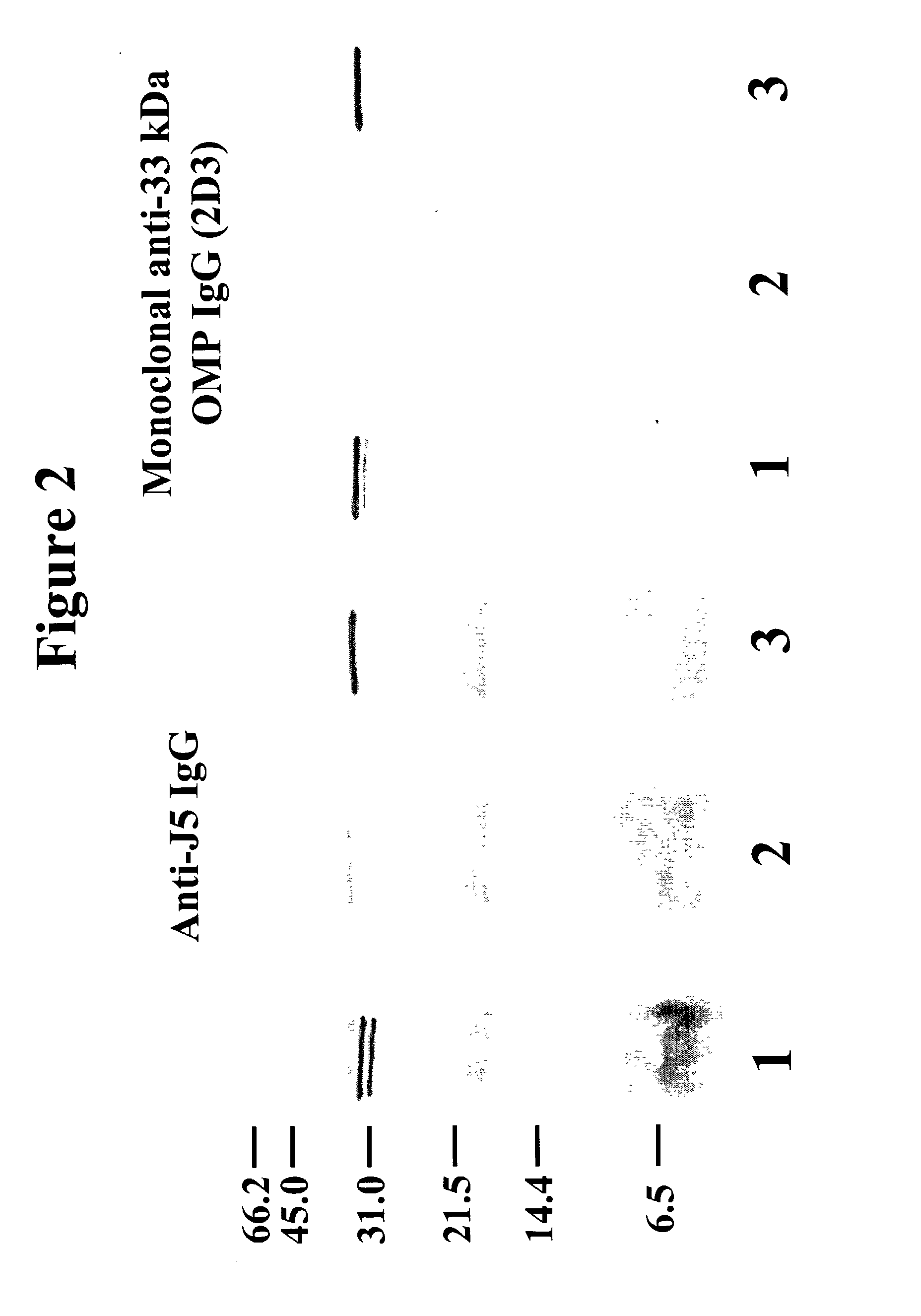Outer membrane protein A, peptidoglycan-associated lipoprotein, and murein lipoprotein as therapeutic targets for treatment of sepsis
a technology of outer membrane protein and lipoprotein, which is applied in the direction of antibacterial agents, peptides, antibacterial ingredients, etc., can solve the problems of advancing to life-threatening hypotension and organ failure, negative bacteria are major causes of morbidity and mortality, and it is difficult to directly demonstrate substantial increased binding to lps from heterologous gram-negative bacteria
- Summary
- Abstract
- Description
- Claims
- Application Information
AI Technical Summary
Benefits of technology
Problems solved by technology
Method used
Image
Examples
example 1
[0113] Monoclonal Antibodies
[0114] Methods. Prior studies indicated that anti-J5 IgG binds three OMPs of MWs 35 kDa, 18 kDa (previously estimated as 37 kDa and 24 kDa respectively: Hellman J et al., J Infect Dis 176:1260-1268 (1997)) and 5-9 kDa, that are present on the bacterial surface and are released into human serum as OMP / LPS complexes. Monoclonal antibodies were prepared against each of the three OMPs bound by IgG in J5 antiserum, and against the O-polysaccharide of E. coli O18 LPS. For production of anti-OMP monoclonal antibodies, BALB / c mice (Charles River Laboratories, Wilmington, Mass.) were immunized with heat-killed, lyophilized E. coli J5 vaccine prepared as described. Siber G R et al., J Infect Dis 152:954-964 (1985). Vaccine was resuspended in sterile normal saline (1 mg / ml). Increasing doses were injected intraperitoneally 3 times per week for three weeks (0.1 mg, 0.2 mg, and 0.3 mg). Booster injections were given monthly for 1-3 months, with the final booster three...
example 2
[0122] Identification of OmpA
[0123] We hypothesized that the 35 kDa protein was OmpA based upon the apparent molecular weight and the fact that the electrophoretic mobility of the band was altered by boiling. Hindennach I and Henning U, Eur J Biochem 59:207-213 (1975). Immunoblotting studies were performed to identify this protein.
[0124] Recombinant outer membrane protein A (OmpA). The coding region of the 325 amino acid mature OmpA protein, excluding the 21 amino acid signal sequence (GenBank accession #V00307), was generated by PCR amplification of DNA from an extract of E. coli O18:K1:H7. OmpA-specific PCR primers OmpABacl and OmpABac2 contained 5' extensions for cloning into the transfer plasmid pBACgus-2 cp (Novagen, Madison, Wis.).
[0125] OmpABac 1: 5'-GACGACGACAAGGCTCCGAAAGATAACACCTG-3' (SEQ ID NO: 1)
[0126] OmpABac2: 5'-GAGGAGAAGCCCGGTTAAGCCTGCGGCTGAGTTAC-3' (SEQ ID NO:2)
[0127] The transfer plasmid containing the OmpA coding sequence (OmpA / pBACgus-2 cp) was then transfected in...
example 3
[0130] Identification of PAL
[0131] Methods. The final purification procedure for the 18 kDa OMP consisted of: 1) preparation of total bacterial membranes, 2) Triton X-100 extraction of bacterial membranes, 3) affinity chromatography using sepharose beads conjugated with 6D7 (the anti-18 kDa OMP monoclonal antibody), and 4) reverse-phase HPLC separation. The purification steps are described below.
[0132] Total bacterial membranes were prepared from mid-late log-phase cultures of E. coli O18K bacteria essentially as described. Hellman J et al., J Infect Dis 176:1260-1268 (1997); Munford RS et al., J Bacteriol 144:630-640 (1980). Unless otherwise indicated, all steps were performed at 4-6.degree. C. 2 L cultures of bacteria were harvested by centrifugation and the resultant pellets were resuspended in a total of 60 ml pre-chilled 10 mM HEPES buffer (pH 7.4) with 25% sucrose (w / v) and 0.2 mM dithiothreitol (DTT, Fisher Biochemicals, Fair Lawn, N.J.). RNase and DNase (Sigma, St. Louis) we...
PUM
| Property | Measurement | Unit |
|---|---|---|
| MW | aaaaa | aaaaa |
| pH | aaaaa | aaaaa |
| constant current | aaaaa | aaaaa |
Abstract
Description
Claims
Application Information
 Login to View More
Login to View More - R&D
- Intellectual Property
- Life Sciences
- Materials
- Tech Scout
- Unparalleled Data Quality
- Higher Quality Content
- 60% Fewer Hallucinations
Browse by: Latest US Patents, China's latest patents, Technical Efficacy Thesaurus, Application Domain, Technology Topic, Popular Technical Reports.
© 2025 PatSnap. All rights reserved.Legal|Privacy policy|Modern Slavery Act Transparency Statement|Sitemap|About US| Contact US: help@patsnap.com



